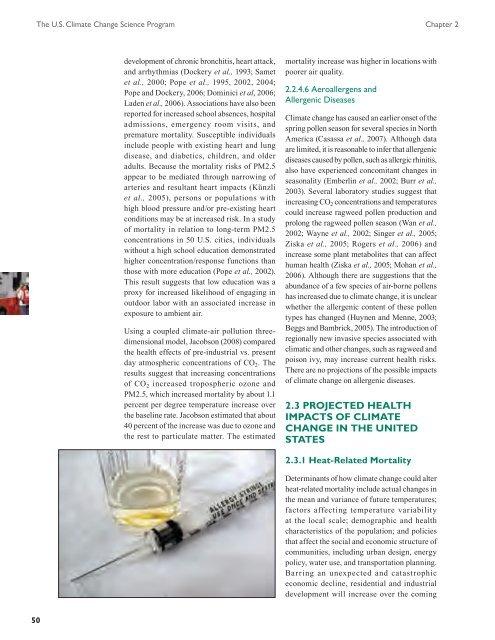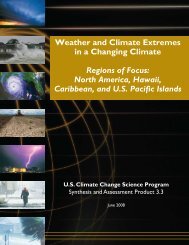Analyses of the Effects of Global Change on - US Climate Change ...
Analyses of the Effects of Global Change on - US Climate Change ...
Analyses of the Effects of Global Change on - US Climate Change ...
Create successful ePaper yourself
Turn your PDF publications into a flip-book with our unique Google optimized e-Paper software.
The U.S. <strong>Climate</strong> <str<strong>on</strong>g>Change</str<strong>on</strong>g> Science Program Chapter 2<br />
50<br />
development <str<strong>on</strong>g>of</str<strong>on</strong>g> chr<strong>on</strong>ic br<strong>on</strong>chitis, heart attack,<br />
and arrhythmias (Dockery et al., 1993; Samet<br />
et al., 2000; Pope et al., 1995, 2002, 2004;<br />
Pope and Dockery, 2006; Dominici et al, 2006;<br />
Laden et al., 2006). Associati<strong>on</strong>s have also been<br />
reported for increased school absences, hospital<br />
admissi<strong>on</strong>s, emergency room visits, and<br />
premature mortality. Susceptible individuals<br />
include people with existing heart and lung<br />
disease, and diabetics, children, and older<br />
adults. Because <str<strong>on</strong>g>the</str<strong>on</strong>g> mortality risks <str<strong>on</strong>g>of</str<strong>on</strong>g> PM2.5<br />
appear to be mediated through narrowing <str<strong>on</strong>g>of</str<strong>on</strong>g><br />
arteries and resultant heart impacts (Künzli<br />
et al., 2005), pers<strong>on</strong>s or populati<strong>on</strong>s with<br />
high blood pressure and/or pre-existing heart<br />
c<strong>on</strong>diti<strong>on</strong>s may be at increased risk. In a study<br />
<str<strong>on</strong>g>of</str<strong>on</strong>g> mortality in relati<strong>on</strong> to l<strong>on</strong>g-term PM2.5<br />
c<strong>on</strong>centrati<strong>on</strong>s in 50 U.S. cities, individuals<br />
without a high school educati<strong>on</strong> dem<strong>on</strong>strated<br />
higher c<strong>on</strong>centrati<strong>on</strong>/resp<strong>on</strong>se functi<strong>on</strong>s than<br />
those with more educati<strong>on</strong> (Pope et al., 2002).<br />
This result suggests that low educati<strong>on</strong> was a<br />
proxy for increased likelihood <str<strong>on</strong>g>of</str<strong>on</strong>g> engaging in<br />
outdoor labor with an associated increase in<br />
exposure to ambient air.<br />
Using a coupled climate-air polluti<strong>on</strong> threedimensi<strong>on</strong>al<br />
model, Jacobs<strong>on</strong> (2008) compared<br />
<str<strong>on</strong>g>the</str<strong>on</strong>g> health effects <str<strong>on</strong>g>of</str<strong>on</strong>g> pre-industrial vs. present<br />
day atmospheric c<strong>on</strong>centrati<strong>on</strong>s <str<strong>on</strong>g>of</str<strong>on</strong>g> CO 2. The<br />
results suggest that increasing c<strong>on</strong>centrati<strong>on</strong>s<br />
<str<strong>on</strong>g>of</str<strong>on</strong>g> CO 2 increased tropospheric oz<strong>on</strong>e and<br />
PM2.5, which increased mortality by about 1.1<br />
percent per degree temperature increase over<br />
<str<strong>on</strong>g>the</str<strong>on</strong>g> baseline rate. Jacobs<strong>on</strong> estimated that about<br />
40 percent <str<strong>on</strong>g>of</str<strong>on</strong>g> <str<strong>on</strong>g>the</str<strong>on</strong>g> increase was due to oz<strong>on</strong>e and<br />
<str<strong>on</strong>g>the</str<strong>on</strong>g> rest to particulate matter. The estimated<br />
mortality increase was higher in locati<strong>on</strong>s with<br />
poorer air quality.<br />
2.2.4.6 Aeroallergens and<br />
Allergenic Diseases<br />
<strong>Climate</strong> change has caused an earlier <strong>on</strong>set <str<strong>on</strong>g>of</str<strong>on</strong>g> <str<strong>on</strong>g>the</str<strong>on</strong>g><br />
spring pollen seas<strong>on</strong> for several species in North<br />
America (Casassa et al., 2007). Although data<br />
are limited, it is reas<strong>on</strong>able to infer that allergenic<br />
diseases caused by pollen, such as allergic rhinitis,<br />
also have experienced c<strong>on</strong>comitant changes in<br />
seas<strong>on</strong>ality (Emberlin et al., 2002; Burr et al.,<br />
2003). Several laboratory studies suggest that<br />
increasing CO 2 c<strong>on</strong>centrati<strong>on</strong>s and temperatures<br />
could increase ragweed pollen producti<strong>on</strong> and<br />
prol<strong>on</strong>g <str<strong>on</strong>g>the</str<strong>on</strong>g> ragweed pollen seas<strong>on</strong> (Wan et al.,<br />
2002; Wayne et al., 2002; Singer et al., 2005;<br />
Ziska et al., 2005; Rogers et al., 2006) and<br />
increase some plant metabolites that can affect<br />
human health (Ziska et al., 2005; Mohan et al.,<br />
2006). Although <str<strong>on</strong>g>the</str<strong>on</strong>g>re are suggesti<strong>on</strong>s that <str<strong>on</strong>g>the</str<strong>on</strong>g><br />
abundance <str<strong>on</strong>g>of</str<strong>on</strong>g> a few species <str<strong>on</strong>g>of</str<strong>on</strong>g> air-borne pollens<br />
has increased due to climate change, it is unclear<br />
whe<str<strong>on</strong>g>the</str<strong>on</strong>g>r <str<strong>on</strong>g>the</str<strong>on</strong>g> allergenic c<strong>on</strong>tent <str<strong>on</strong>g>of</str<strong>on</strong>g> <str<strong>on</strong>g>the</str<strong>on</strong>g>se pollen<br />
types has changed (Huynen and Menne, 2003;<br />
Beggs and Bambrick, 2005). The introducti<strong>on</strong> <str<strong>on</strong>g>of</str<strong>on</strong>g><br />
regi<strong>on</strong>ally new invasive species associated with<br />
climatic and o<str<strong>on</strong>g>the</str<strong>on</strong>g>r changes, such as ragweed and<br />
pois<strong>on</strong> ivy, may increase current health risks.<br />
There are no projecti<strong>on</strong>s <str<strong>on</strong>g>of</str<strong>on</strong>g> <str<strong>on</strong>g>the</str<strong>on</strong>g> possible impacts<br />
<str<strong>on</strong>g>of</str<strong>on</strong>g> climate change <strong>on</strong> allergenic diseases.<br />
2.3 PROjECTED HEALTH<br />
IMPACTS OF CLIMATE<br />
CHANGE IN THE UNITED<br />
STATES<br />
2.3.1 Heat-Related Mortality<br />
Determinants <str<strong>on</strong>g>of</str<strong>on</strong>g> how climate change could alter<br />
heat-related mortality include actual changes in<br />
<str<strong>on</strong>g>the</str<strong>on</strong>g> mean and variance <str<strong>on</strong>g>of</str<strong>on</strong>g> future temperatures;<br />
factors affecting temperature variability<br />
at <str<strong>on</strong>g>the</str<strong>on</strong>g> local scale; demographic and health<br />
characteristics <str<strong>on</strong>g>of</str<strong>on</strong>g> <str<strong>on</strong>g>the</str<strong>on</strong>g> populati<strong>on</strong>; and policies<br />
that affect <str<strong>on</strong>g>the</str<strong>on</strong>g> social and ec<strong>on</strong>omic structure <str<strong>on</strong>g>of</str<strong>on</strong>g><br />
communities, including urban design, energy<br />
policy, water use, and transportati<strong>on</strong> planning.<br />
Barring an unexpected and catastrophic<br />
ec<strong>on</strong>omic decline, residential and industrial<br />
development will increase over <str<strong>on</strong>g>the</str<strong>on</strong>g> coming




